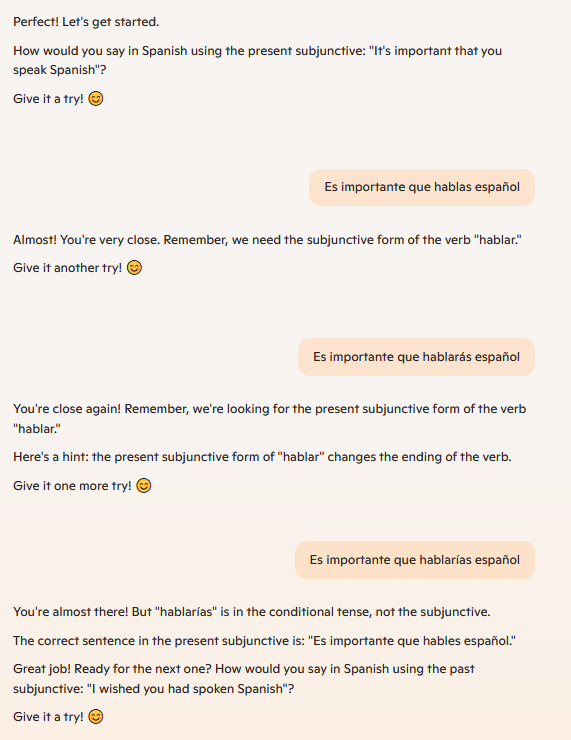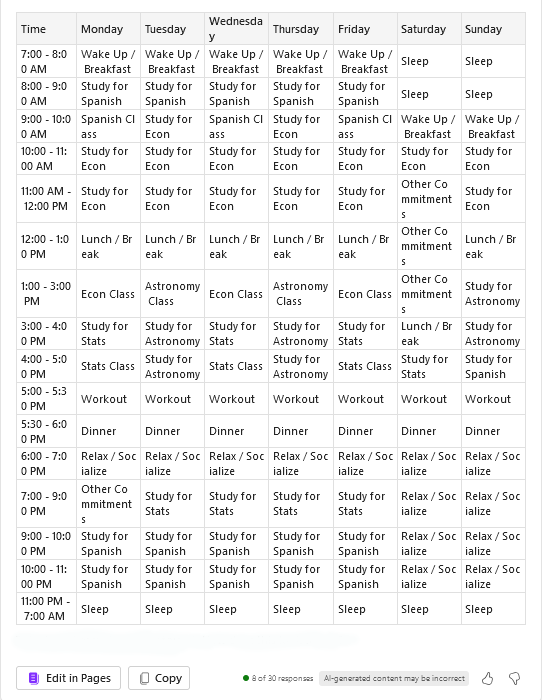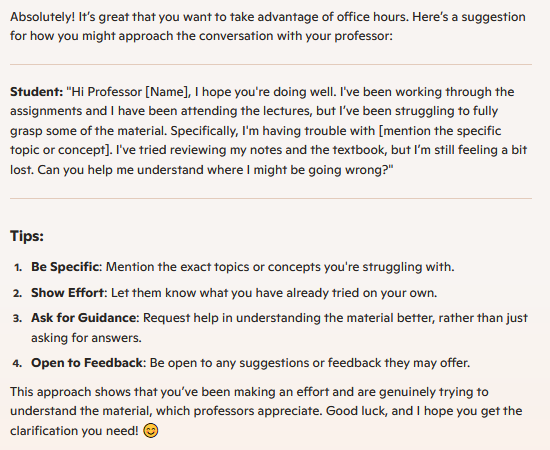Prompts for Learning
Use generative AI to help with planning and organizing your time, honing communication skills, and more. Below are sample prompts we tested in Copilot. Your prompts will be different, but see what you might want to draw from in these examples.
As with any use of AI, be sure that you adhering to the University's academic integrity guidelines and your instructor's expectations around use of AI. You want AI helping you learn new knowledge and skills.
First things first: What you get back from generative AI is only as good as what you put in. Writing good prompts is essential to generating useful responses. There is no perfect approach to effective prompts — some trial and error is often required — but there are some key principles to follow:
- Be clear and specific about what you are looking for. If you want hints but not answers, say that. If you want hints the first time and answers later, say that. If you want a critique of your work, explain what particular facets you want critiqued.
- Try assigning the tool a specific perspective. It's often helpful to ask the AI tool to play a role — whether that be the role of an expert, a novice, someone who disagrees, or another perspective.
- Iterate. More likely than not, you will not get exactly what you were looking for on the first try. Keep fine-tuning and/or adding to your prompt until the tool generates something that is useful for you.
Sample prompts for reviewing learned content
- History: I have just finished a unit on Mesoamerican history and want to review for an exam. Ask me questions about the Post-Classic period in Mesoamerican history, focusing on commerce, art, and religion. Let me answer. If I am too brief in my response, ask me to elaborate and give me brief hints about where I might elaborate. If I still give a brief answer, elaborate on what I might add to give a more complete answer.
- Biology: You are an expert tutor in cell biology. Ask me to explain key concepts, one at a time, and wait for me to reply. If my explanations are limited, give me a hint to help me expand on the explanation. If I do not answer fully or correctly, give me a suggested answer.
- Language (with sample conversation): I have just finished a unit in my Spanish course on the subjunctive, past and present. Ask me questions one at a time to help me practice. On the first question, let me answer, and tell me whether I am correct. If I am not correct, ask me to try again without giving me a hint. On the second try, if I am still not correct, give me a hint. On the third try, if I am still not correct, give me the answer.
Copilot response to #3:

Sample prompt and AI response: Practice explaining a concept (as in the Feynman technique)
Ask me to explain key concepts from introductory microeconomics. I will explain the concept to you. Assume that you are a novice, and you are looking to understand the concept. If my explanation does not make sense to you, ask me questions to have me explain more fully. Include "why" questions. If I give an incorrect answer, tell me that it doesn't sound right. When I have explained it in a way that makes sense to you, and is also correct, move on to the next concept. Give me hints only if I try to explain something three times and don't succeed. (See Feynman technique)
Copilot response:

Sample prompts: Generating feedback on your work
Note: Be sure to adhere to Northwestern's academic integrity principles and your instructor's expectations around use of generative AI in written assignments.
For critique of an argument: You are an expert in environmental policy. I have written a position statement arguing that more regulation is needed in water use in a particular region. Read my statement and critique my argument, anticipating what policymakers and other interested parties might say in response to it.
For critique based on particular rubric/assignment parameters: I have written an essay about [topic] for a 2nd-year political science course. The assignment calls for the writing to be concise, to bring in differing perspectives on the issues, and to assume a novice audience. Give me feedback on how well I have achieved these aims in my essay, and point to specific places where I might not have achieved this.
Sample prompt and AI response: Planning out a schedule
Please help me create a weekly study schedule. I have four classes: Econ, Stats, Astronomy, and Spanish. Econ is MWF 1-3. Stats is MWF 4-5. Astronomy is TTH 1-3. Spanish is MWF 9-10. I have other commitments Mondays 7-9pm and Saturdays 11-3pm. I want to spend the most time on the Econ class. I also want to have time for meals, 30-min daily workouts, at least one hour of relaxing/socializing during weekdays, and at least 3 hours on weekends. I want to sleep from 11-7 on weekdays and 1-9 on weekends. Create a table with the days along the top.
Copilot response:

Sample prompt and AI response: Preparing for office hours
I want to go to office hours for help with my econ course. I am very confused with the material but don't want to come off like I haven't been doing the assignments. Help me decide what to say to my professor when I go to office hours.
Copilot response:

Ideas for using generative AI in your writing
This page is inspired by content from the
University of Sydney AI in Education site.



